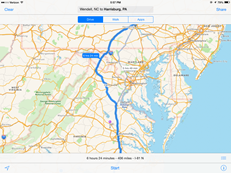Last week, I hauled a load from eastern North Carolina up to northern Pennsylvania. The proposed route that my GPS and Google maps suggested took me around Washington D.C. on I-495 and it would be around 4 pm when I got there. As most of you know, this is one of the worst traffic regions in the country and a delay of at least an hour is the norm for that time of day. The hour delay is only if there are no accidents. If accidents occur, then plan on adding even more travel time to the trip. 
I chose a route that would take me away from that traffic disaster, but would add approximately 30 miles to the trip. I hated to run the extra miles, but it was a strategic decision that benefited me the most. Although I added 30 miles of fuel to the trip, I never experienced any traffic snarls and I'm confident that I even saved 30 minutes of time by avoiding the Capital Beltway.
Even though the shorter route would save me 30 miles, the added time and fuel consumption of starting and stopping in traffic for at least an hour really made the decision a no brainer! A wise old man once said, "You can make more money, but you can't make more time." That's something else to consider when choosing routes.